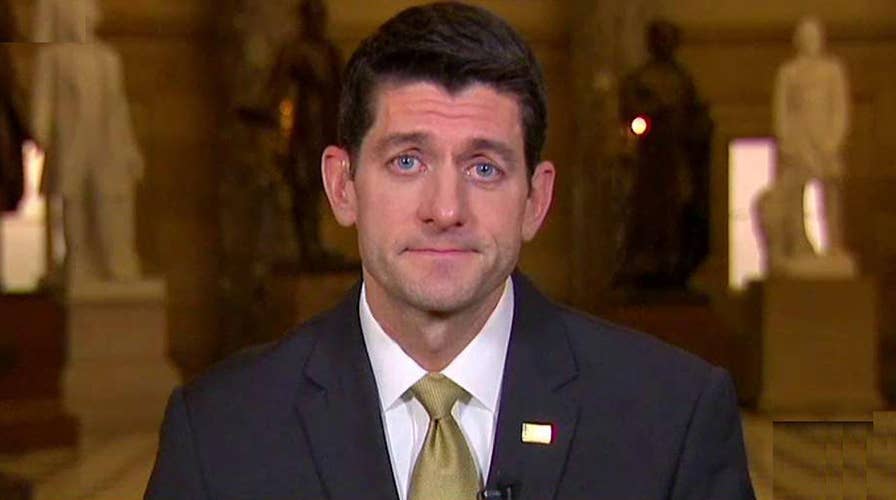Paul Ryan: We must 'unite the clans' in the GOP
House Speaker goes 'On the Record' on his call for Republican unity in his speech at Heritage Action Conservative Policy Summit, his meeting with Pres. Obama and the latest in 2016 presidential race
President Obama on Tuesday delivers his annual budget proposal to Congress. And congressional Republicans will immediately excoriate him for the course he charts in the non-binding spending blueprint.
It focuses on the wrong things. The priorities are way out of whack. It spends too much. Where are the cuts? Aren’t we running a $19 trillion debt?
In fact, House Budget Committee Chairman Tom Price, R-Ga., and Senate Budget Committee Chairman Mike Enzi, R-Wyoming, will ignore Obama’s budget package.
“It appears the president’s final budget will continue to focus on new spending proposals instead of confronting our government’s massive overspending and debt,” Enzi recently said.
The duo won’t hold the standard hearings questioning administration officials about the president’s budget. Instead, Enzi and Price will skip straight into crafting their own budgets and castigate what the White House engineered.
The office of House Speaker Paul Ryan, R-Wis., published a treatise Friday titled: “They Just Don’t Care.” In the missive, Ryan’s office declared that “nothing will deter (House Republicans) from moving forward with our positive agenda.”
It said the House wouldn’t “get bogged down in distractions and fantasy proposals that go nowhere.”
The release argued that Democrats tried to portray Republicans “as the party of no.”
Congress faces a crushed calendar this year. Two conventions this summer. Weeks on end reserved for campaigning.
Of course, it doesn’t have to be this way. But the GOP congressional brain trust etched out this docket to accommodate the political season.
That’s why House Majority Leader Kevin McCarthy, R-Calif., hoped to advance the chamber’s own budget in early March. Then the House could move expeditiously through the 12 appropriations bills that fund the government.
“A return to regular order” was the signature credo conservative House members demanded from Ryan when he first clutched the speaker’s gavel.
But it went deeper than that.
Even stalwart supporters of former House Speaker John Boehner, R-Ohio, demanded that Congress get back to the “proper” way of doing things. Pass a budget to establish a topline spending figure for the fiscal year, then approve individual appropriations bills one by one.
This prevents the need to glom the bills together in some colossal “omnibus” or “CRomnibus” fur ball later this year.
Approving the bills separately would eliminate the need for emergency “Continuing Resolutions” (sometimes called CR’s) to avoid a classic Washington crisis and a government shutdown.
Guess what? The time squeeze makes it a challenge to knock out those appropriations bills at a breakneck pace. That calls for “regular order?”
Almost everyone on Capitol Hill understands the inherit problem facing House Republicans prior to reaching the appropriations phase: passing a budget.
Yes. Not a budget Obama cooked up. A budget crafted by Tom Price.
Failing to approve a budget would emerge as an embarrassment for House Republicans clamoring for a “return to regular order.”
Never mind that Ryan was the much-heralded House Budget Committee chairman for many years and authored the fabled “Ryan Budget.”
Here’s the other issue: The lack of a budget resolution impedes passage of any of the spending bills. Plus, it robs Republicans of a very special, parliamentary tool called “budget reconciliation,” which can sidestep Senate filibusters.
Budget reconciliation measures are elite packages that can be used as a political weapon against the other party or bypass nettlesome Senate issues to approve controversial policy changes.
First, a look at the operations of trying to approve a congressional budget, then a dive into the political realities that complicate passing a budget.
+++++++++++++++++++
It’s important to understand what constitutes a congressional budget. It’s just what it sounds like. A budget lays out all federal expenditures for the coming fiscal year. The entire government spent a total of about $3.6 trillion in fiscal 2015.
That includes every dollar spent on entitlement programs such as Medicare, Medicaid and Social Security (which account for close to 70 percent federal spending).
It also includes the remaining part for running military programs or the Department of Interior. Congress refers to the former section of spending as “mandatory” because lawmakers don’t adjudicate how that money is spent.
It just flows out the door based on what entitlement benefits people are owed. Congress doesn’t annually dedicate funds for entitlements. Members of Congress refer to the second section of spending as “discretionary.”
That’s because lawmakers have “discretion” over how to spend that money. Congress decides to send X dollars to the Pentagon and Y dollars to the Department of Interior and so-on.
Just before he left office, then-House Speaker John Boehner, R-Ohio, cut a deal with the president to avoid an immediate government shutdown.
The plan would also raise the debt ceiling and establish a “discretionary” spending figure of about $1.07 trillion. Congress can then divide the total discretionary figure into 12 unequal parts (representing each of the 12 appropriations bills) to fund each section of government.
However, Congress must first adopt an annual budget to dictate the total spending figure for mandatory and discretionary spending. Failing to do so provides House Appropriations Committee Chairman Hal Rogers, R-Ky., scant guidance as to the size of his spending pie.
It paralyzes the appropriations process right there -- to say nothing of the quandary facing Republicans who want to restore “regular order.”
However, a parliamentary work-around exists for not passing a budget.
The House and Senate can always just “deem” that it approved a “budget” in order to start cranking through appropriations.
“Deeming” is a make-believe way for Congress to say it did something -- even if it really didn’t. Such an ad hoc-tool usually involves language latched to another legislative measure so Congress doesn’t have to deal with the underlying issue at hand.
But importantly, deeming falls short of approving an actual budget resolution. Deeming only dictates a discretionary spending number.
Appropriators then know the size of their pie and can slice it to comprise the 12 spending bills. Plus, deeming robs lawmakers of any opportunity to use the special budget reconciliation gambit to navigate tricky Senate waters.
Deeming resolutions are not unheard of. The House or Senate have initiated nine deeming resolutions in recent years. A provision in the Boehner-Obama pact also stipulates that the Senate can adopt a deeming resolution between April 15 and May 15 to establish appropriations spending levels.
You think Freedom Caucus members are upset at the way Boehner ran the show? Imagine the acrimony if the House “deems” the spending number for this appropriations cycle.
But if things go south on a budget, deeming may be the only option available if House Republicans want to approve standalone appropriations bills and not face an omnibus spending bill or CR later.
Now, let’s evaluate the political roadblocks to passing a budget.
House Freedom Caucus members are balking at approving a budget that complies with the Boehner-Obama deal and triggers an appropriations spending level of approximately $1.07 trillion for fiscal 2017 (which starts October 1).
Conservatives can’t score cuts from the mandatory side of the spending ledger. But they can chop into the discretionary side. Members of the Freedom Caucus are pushing for a discretionary figure ranging between $20 to $70 trillion below the Boehner/Obama floor.
Many Freedom Caucus members say their constituents demand additional spending cuts. Moreover, they don’t think that Ryan should have to adhere to the deal forged by the former speaker
and Obama.
Never mind the argument that both bodies of Congress approved the Boehner-Obama legislation. Therefore, sticking to the $1.07 trillion discretionary spending number would be following “regular order.”
The House Freedom Caucus commands 40-plus votes in the 246-member House Republican Conference. Attrition among that group could imperil the GOP’s efforts to approve a budget. It would ignite a firestorm if Republicans leaned on Democrats to adopt a budget.
Such a maneuver would certainly come at a price for Ryan. Democrats would extract concessions in a budget resolution reflecting their priorities in exchange for their votes.
Don’t forget what happened to the last speaker when he repeatedly sought Democratic votes on major issues. (That was Boehner, and he was essentially forced out.)
And nobody has said anything about the potential duplicity that lurks around the corner if congressional Republicans upbraid Obama for his budget request -- while the GOP can’t even strike an agreement on a budget of its own.
This reflects the continued dissonance inside the GOP. As more than one lawmaker put it, “New Speaker, same members.”
And the same problems.
Ryan propounds a “bottom-up” approach to governing. As the former Budget Committee chairman, he must resist stage-managing the budget from the speaker’s office, leaving the heavy lifting to Price.
But can that get the job done? Don’t forget that McCarthy paid a late-night visit to a meeting to the Budget Committee last year to solve an impasse -- going over the head of Price.
Since Ryan moved into the speaker’s suite, numerous observers characterized various obstacles as his first “big test.” Could he pass a transportation measure?
Could he avoid shuttering the government with an omnibus spending bill? Would he infuriate conservatives if the House renewed the controversial Export-Import Bank? How about drafting a bill to bolster Syrian refugee screening?
All were big tests. But passing a budget and working through the appropriations bills truly constitutes the “first big test” facing the now not-so-new speaker of the House.





